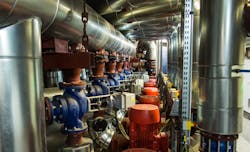Quiz Corner: What is the pump system efficiency?
What is the efficiency of a pump system that pumps 100 gallons per minute of water at a pressure of 100 feet of water column using a 7.5-horsepower motor?
This question is woefully deficient of information needed to calculate pump efficiency. Nonetheless, we can examine different approaches to reaching a solution.
A quick way to estimate pumping efficiency is to confirm the pump is operating on its pump curve, read the efficiency of the pump at this operating condition from the pump curve, and then multiply it by an estimated motor efficiency. Note that the pump curve (if available) reflects a new pump, which may not be an accurate representation of an existing pump that may be worn.
The pump system efficiency is the ratio of the hydraulic energy produced to the electrical energy consumed. The hydraulic energy produced can be calculated as:
100 gpm x 100 feet x 1.00 specific gravity / 3960 = 2.53 horsepower
The electrical energy consumed at this operating condition can be measured with a portable instrument that measures the electrical energy consumed by the motor. The efficiency of the pump system can then be calculated.
Additional complicating factors
The hydraulic energy calculation assumes that the pump suction pressure is atmospheric. Taking the static head of the water in the tank (above the pump suction) and any pressure that may be in the tank above the water will complicate this calculation.
David W. Spitzer is a regular contributor to Flow Control magazine and a principal in Spitzer and Boyes LLC, which offers engineering, seminars, strategic, mar-keting consulting, distribution consulting and expert witness services for manu-facturing and automation companies. Spitzer and Boyes is also the publisher of the Industrial Automation INSIDER. He has more than 40 years of experience and has written more than 10 books and 350 articles about flow measurement, instrumentation and process control.
Spitzer may be reached at 845-623-1830 or via spitzerandboyes.com. Click on the "Products" tab to find his Consumer Guides to various flow and level measurement technologies.
About the Author
David W. Spitzer
David W Spitzer’s new book Global Climate Change: A Clear Explanation and Pathway to Mitigation (Amazon.com) adds to his over 500 technical articles and 10 books on flow measurement, instrumentation, process control and variable speed drives. David offers consulting services and keynote speeches, writes/edits white papers, presents seminars, and provides expert witness services at Spitzer and Boyes LLC (spitzerandboyes.com or +1.845.623.1830).
